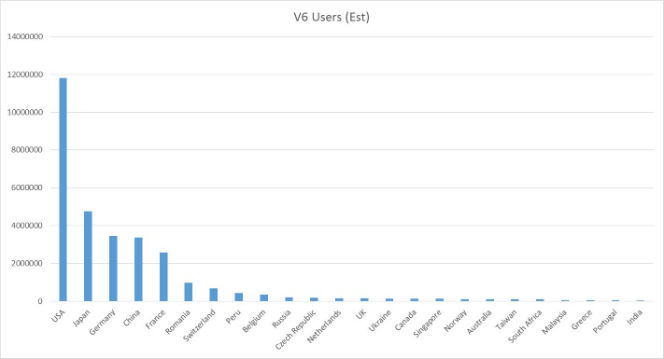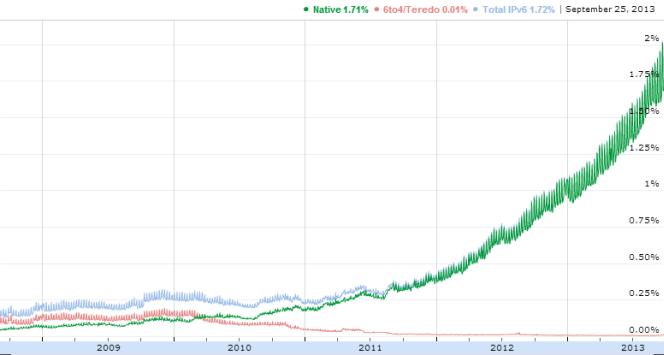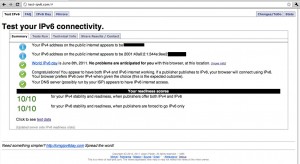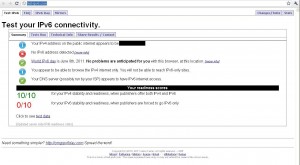
Media interest in IPv6 last week prompted a few questions, notably on twitter, regarding whether people should worry about the IPv4 address pool exhaustion. It would be easy to make noise and attract attention by saying “OMG yes – you should worry”. After all it is a fairly momentous event –> “The End of The Internet As We Know It”. ARMAGEDDON!!!
This blog does not indulge in such tabloid-like scaremongering 🙂 So what is the deal?
Well firstly it is very true that the IANA IPv4 address pool is about to run out. There are only seven /8 address block remaining and Asian Regional Internet Registries (RIRs ) APNIC is about to ask for two of these. The growth of internet usage in Asia has been outpacing the rest of the world.
Word has it that APNIC has been holding back on this request to a) stretch the exhaustion date and b) give IANA a chance to organise the PR surrounding the release of the final blocks. Once APNIC has received its two blocks (each /8 contains approx 16 million IPv4 addresses) we will be down to the last five. This is expected to happen in January – or mid February at the latest.
The rule is that this is the point at which IPv4 exhaustion is declared and the remaining five blocks are distributed to the five RIRs. The last five should be released in March. (all dates subject to change in this rapidly changing world)
Of course whilst this means that IANA will no longer have any addresses each RIR will. It should, however, be remembered that /8 blocks are being used up at the rate of one every 6 weeks or so. It won’t be long before RIRs will run out of stock. It will then be down to individual ISPs to nurture their own stocks so that they last as long as possible. I have already heard (anecdotal) stories of companies being bought for their IPv4 addresses, at least in part.
ISPs can make their stocks last longer by getting better at recycling IPv4 addresses from customers who have left for pastures new. These ISPs will need to move to IPv6 or, in the medium term, depart the market because they will not be able to service new customers– enter tabloid press – ISPS HIT WALL AND GO OUT OF BUSINESS PANIC/STAMPEDE/WILL MINE BE ONE OF THEM? !!!
The industry has known this has been coming for a long time – more than 10 years so what’s the state of play?
The global network penetration of IPv6 is still quite low – only a few % – it does vary from country to country. This means that relatively few networks can talk to each other using IPv6. This rate of adoption is increasing as D-Day gets closer (Depletion Day?).
The migration strategy for IPv6 implementation is to run dual stack networks ie to run both IPv4 and IPv6 in parallel. Existing ISP customers will be able to continue to use their existing “IPv4 only” routers. IPv4 is not going away in a hurry. However you should know that once IPv4 has been “used up” new websites and services will start to appear that only use IPv6. If your ISP cannot provide IPv6 then it is quite probable that you will not be able to access services that only use IPv6. With time this will be a growing problem.
Consumers
As long as your ISP does support IPv6 then your routers don’t need to – the ISP can do a Network Address Translation on your behalf. After all end users don’t typically see their IP address. End users use the friendlier DNS system for sending emails and web browsing eg trefor.net sits at IP address 62.121.11.173 but you don’t need to know the underlying number – the system takes care of it for you.
Their problem will be if their ISP does not support IPv6 then they will not be able to help when trefor.net (or any other DNS based service) moves to IPv6.
Now consumers don’t need to rush out and buy a new router. For one if their ISP does not yet support IPv6 it would be a waste of money, but they do need to be sure in the medium term that the ISP has an IPv6 story. The other point to note is that routers don’t last for ever and do periodically get replaced as technology develops. For example in moving from 8Mbps to 24Mbps broadband many people will have had to have a new router.
One of the things holding back the release of IPv6 to consumers is the lack of support for the protocol amongst consumer broadband router vendors. The market leader for IPv6 equipment support is Cisco, whose kit is typically used in business environments. Cisco routers are too expensive for home users who expect to get the equipment bundled with their broadband connection for free or at least a very low price.
There are very few alternatives with fully working solutions – these vendors are only now just sampling their first devices to their ISP channel.
There is no real reason for this, other than a perceived lack of market demand, because ADSL routers typically all use the same open source (ie free) Linux kernel. Linux is the pet project of a global engineering community and provides good IPv6 support. We should therefore expect to see many IPv6 enabled broadband routers appearing in the market during the course of 2011 which will likely trigger more ISP IPv6 announcements.
Business
A business should give more thought to a plan to migrate its network from IPv4 to IPv6, or to provide support for a dual stack. This is because it might be a bit of a nuisance for consumers to have only partial access to the internet but this could be mission critical for a business, especially if it is that business’ own website and services, or those of its trading partners that become inaccessible.
Up until now this is something that has been completely ignored by the IT manager community but it is something that they should be aware of in 2011.
Support from Cisco and Linux is good news generally as many businesses are heavy users of both Note a business may not know it uses Linux but for example Timico installs IPv6-ready Fortigate firewalls – it is the firewall’s underlying Linux stack that facilitates this.
There is a lot of uncertainty here and I will be arranging some educational workshops to cover this in the near future – watch this space. In the meantime if you want to know more by all means drop me a line at tref at trefor.net.
If you want to learn more about what an ISP does to prepare for IPv6 read about our work at Timico in this previous post. Note since writing that post in December 2010 the number of IPv6 routes supported by Timico has grown from 3,500 to 4,500 which shows how quickly the space is moving.
Geoff Huston also has a good discussion on this subject here.
PS I will update the percentage penetration of IPv6 numbers as I come across them.
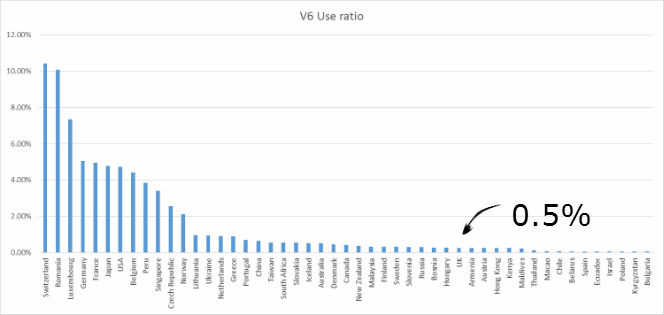 This graph of percentage IPv6 adoption by country as of today, 14th October 2013, was extracted from potaroo.net. It shows the percentage of internet users in each country using IPv6. You can get the exact numbers from potaroo. The UK’s 34th place suggests we are seriously lagging behind. OK we can look at it in terms of actual numbers of users – see the next chart below. We are 13th one this one but take a look at the top 5 – all major competitors in the global commercial stakes.
This graph of percentage IPv6 adoption by country as of today, 14th October 2013, was extracted from potaroo.net. It shows the percentage of internet users in each country using IPv6. You can get the exact numbers from potaroo. The UK’s 34th place suggests we are seriously lagging behind. OK we can look at it in terms of actual numbers of users – see the next chart below. We are 13th one this one but take a look at the top 5 – all major competitors in the global commercial stakes.